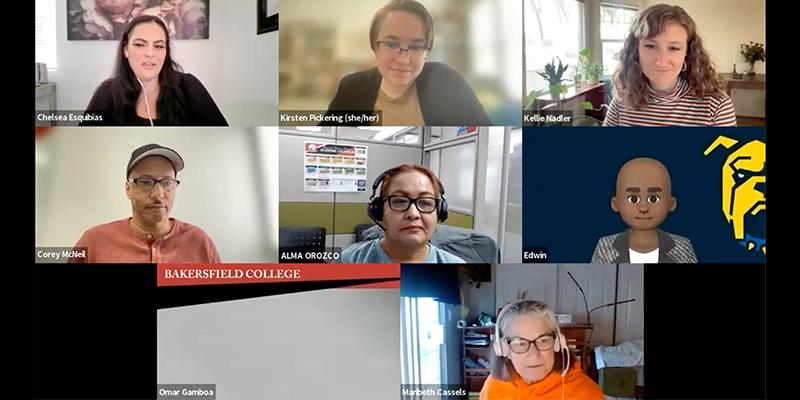In May 2021 the California Department of Corrections and Rehabilitation, agreed to grant Mount Tamalpais College the opportunity to offer students the first computer lab for the only independently accredited liberal arts college in the nation that is located in a prison.
The lab, designed to accommodate 25 students, seats two to three students at elongated tables — socially distanced at 6 feet. In the classroom, students scurry around waiting for Dell computers to come out of the secured storage space. They then log in with their IDs and passwords. All currently enrolled students have full access to the computer lab on a drop-in basis during its open hours.
On a recent visit to the lab, students returned from the day before to access works they started the previous day. Like the library at UC Berkeley or a study hall in USC’s Doheny Library, the lab is very busy.
Informed students assisted new users and worked on essays and presentations — on topics from ecology to Sophocles, to MLK’s “I Have a Dream.” Others prepared rough drafts of poetry, songs, or works that more extensively relate to their aspiring goal of becoming published authors. The room bustled with academia.
Arthur Jackson, a Mount Tamalpais College clerk, was busy helping the lab get open. “The Lab attracts new students — people incarcerated for a long time who are excited because they now practice skills which are transferable to the real world,” said Jackson.
Jackson spoke of an older resident of San Quentin—a single letter man, people who came to prison before August of 2009. Now CDCR is using two letters for people’s identification status. They started with A00000, they are now on CZ0000. “The guy told me this is what rehabilitation should be. Expecting to return to our communities, we can now be more productive because Mount Tamalpais College equips us with new skills.”
He surveyed the classroom. “Look at them. Typing to meet deadlines just like at a real university. With all the camaraderie of the volunteer professors and teachers who provide interconnectivity with inmates, Mt Tam is as diverse as UC Berkeley,” said Jackson.
Carlos Drouaillet, a TA for the lab exclaimed, “Three months ago, we had nothing in relation to computers. During the pandemic, we had to write out our homework for correspondence courses in dark cells, usually having to re-write three or four times in our cells.”
The computers provide basic programs pre-installed on the Dells include Word, Excel, PowerPoint and MS OneNote. There is no internet access, however, there is limited intranet access to whitelisted sites, and Mount Tamalpais College is working to get more sites whitelisted so that students will be able to do research.
Ethan Annis, Anila Yadavalli, Amy Jamgochian, Kirsten Pickering, and Newton Xie all contributed to this project, which took two years to come to fruition. From deciding the model of computers, getting them inside of the facility, where to put them, what programs to put on them, etc. etc. The agreement with the warden was a simpler and more efficient process.
Annis, Librarian and Technology Specialist at Dominican College, supported Amy Jamgochian in the negotiations with CDCR and San Quentin about all the particularities of the computer lab and helped create the Letter of Understanding between the College and San Quentin. Volunteer instructor Xie designed the curriculum for the computer lab’s literacy and orientation program, offering students a five-module program before they begin to use the laptops.
Amy Brunson, the college’s new Director of Library Services and Educational Technology, looks forward to maximizing the college’s computer use and is planning the expansion of technical services at Mt. Tam College. Priya Kandaswamy, the Academic Program Director for MTC who also teaches Introduction to Ethnic Studies, said, “It’s something we’ve tried to do for a long time and we are very excited it’s happening.”
Observations of the lab do not happen without hearing the name Kirsten Pickering. Pickering, who is the Research and Program Fellow at Mount Tamalpais College, instructs the classroom, “Anyone who needs to pick up printing can come with me to the printing station.”
Two men follow her out of classroom B-4 to the administrative hub where print requests are delivered. She also notes there will be a final pick-up of printed materials at 7:30 p.m., approximately 15 minutes before all students must return to their cells.
As the sunset bounces off the actual Mount Tamalpais located outside of San Quentin and radiates into the roof-lined windows, Rudy Moralez tries to improve his academic experience. “The lab helps with my grammar and spelling and corrects my writing fragments,” he says. “I believe it will help my grades improve.”
Pickering says San Quentin’s administration, especially Warden Ron Broomfield, were supportive in coordinating the concerns of CDCR and the college. Broomfield said he envisions the day when a large proportion of prisoners, those dedicated to reformative education and rehabilitation will possess their own laptop computers.
“This ‘child’ has many parents; for years Jody Lewen wanted technology for our students because that’s how college works on the outside,” said Pickering.
Pickering believes challenges operating the lab include expediting the current replacement time for broken computers and the synchronization of laptops to San Quentin’s intranet. “We could easily have more computers from donations, but turnaround time for licensing through CDCR is lengthy,” said Pickering.
Mount Tamalpais College plans to implement the same learning management system that the University of California education system uses.
This system, called Canvas, allows remote lecturers and programs that could increase availability to all students while protecting against future lockdowns.
Pickering spoke of the Canvas system, “Where our vision is to get every student a laptop for equal access, Canvas gives us the same quality as the UC system. CDCR has worked to modify the Canvas program to fit within their specifications…We should incorporate Canvas shortly.”
Pickering spoke of the Peer-to-Peer Computer Lab Assistants who trained with her and STEM Coordinator Anila Yadavalli prior to the installation of the lab. “Quincy, Carlos, Daniel, Ron, Rob, Rufael, C.J. and Rodney were an instrumental part of getting this off the ground.” She added the assistants had to complete rigorous interviews and an orientation that ensured consistency and equal access to all Mount Tamalpais College students.
James Jenkins, who has been incarcerated for 31 years said, “The computer lab is God sent to the extent it enhances our computer and typing skills. It allows me to learn Excel and other apps.
Because of the lab, I am able to do all of my papers, mid-terms and homework here in our classroom. Without this place, I would not be around other motivated peers who share the same hopes and dreams. I would most likely be in my 4 x 8 cell, instead of gaining a whole new outlook on society. Mt Tam has enlightened my behavior towards others.”
Currently 300 other Mt. Tam. students share Jenkins’ vision. Now they can print their visions instead of writing them three to four times. (Read more about MTC computer lab.)
Photo Courtesy of San Quentin News











